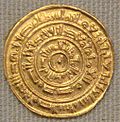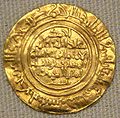| # |
Coin |
Kunya |
Given name |
Regnal name |
Reign |
Birth |
Death |
Remarks |
refs |
| 1 |
 |
Abu Muhammad
أبو محمد |
Abd Allah
عبد الله |
al-Mahdi bi'llah
المهدي |
27 August 909 –
4 March 934 |
873
Salamiyah, Syria |
4 March 934 |
His claim to be the Mahdi caused the Qarmatian schism in 899. Fled Salamiya in 903, and settled at Sijilmasa in 905 while Abu Abdallah al-Shi'i overthrew the Aghlabids and established the Fatimid Caliphate in his name in 909. Fatimid rule over Ifriqiya was consolidated and extended to Sicily, but three attempts to invade Egypt and thence attack the Abbasids failed. |
|
| 2 |
|
Abu'l-Qasim
ابو القاسم |
Muhammad
محمد |
al-Qa'im bi-Amr Allah
القائم بأمر الله |
4 March 934 –
17 May 946 |
893
Salamiyah, Syria |
17 May 946 |
Only son of al-Mahdi bi'llah, his reign was dominated by the Kharijite revolt of Abu Yazid, who reduced the Fatimids to their palace city, al-Mahdiya. |
| 3 |
|
Abu Tahir
أبو طاهر |
Isma'il
اسماعیل |
al-Mansur bi-Nasr Allah
المنصور بنصر الله |
17 May 946 –
18 March 953 |
913
Raqqada |
18 March 953 |
Defeated the rebellion of Abu Yazid, and resumed the war against the Byzantines in southern Italy. |
|
| 4 |
 |
Abu Tamim
أبو تميم |
Ma'ad
معد |
al-Mu'izz li-Din Allah
المعز لدين الله |
19 March 953 –
18 December 975 |
26 September 931 |
18 December 975 |
His general Jawhar occupied most of the Maghreb for him, and proceeded to conquer Egypt in 969. In 973, al-Mu'izz moved the Fatimid court and capital to newly founded Cairo. The Zirids were left in Ifriqiya as Fatimid viceroys. |
|
| 5 |
|
Abu Mansur
أبو منصور |
Nizar
نزار |
al-Aziz bi'llah
العزيز بالله |
18 December 975 –
13 October 996 |
10 May 955 |
14 October 996 |
Succeeded in expanding Fatimid control over most of Syria, where he entered into conflict with the Byzantines over Aleppo. |
[1] |
| 6 |
 |
Abu Ali
أبو علي |
Mansur
المنصور |
al-Hakim bi-Amr Allah
الحاكم بأمر الله |
14 October 996 –
13 February 1021 |
13 August 985 |
13 February 1021 (disappeared) |
Concluded a lasting peace with the Byzantines in 1000. He is a respected religious figure due to his divine knowledge and extra ordinary personality. He disappeared, and was likely murdered, during a night excursion. |
|
| 7 |
|
Abu'l-Hasan
ابو الحسن |
Ali
علي |
al-Zahir li-i'zaz Din Allah
الظاهر لإعزاز دين الله |
13 February 1021 –
13 June 1036 |
20 June 1005 |
13 June 1036 |
His reign represents a return to normality after al-Hakim's turbulent final years. |
|
| 8 |
 |
Abu Tamim
أبو تميم |
Ma'ad
معد |
al-Mustansir bi'llah
المستنصر بالله |
13 June 1036[a] –
29 December 1094/ 6 January 1095[6][7] |
2 July 1029
Cairo |
29 December 1094/ 6 January 1095[8][9]
Cairo |
The longest-reigning Fatimid caliph, his reign saw increasing political instability and the near collapse of the dynasty at the hands of the Sunni warlord Nasir al-Dawla ibn Hamdan. The Armenian general Badr al-Jamali restored order and saved the dynasty, but installed himself as a virtual military dictator ("vizier of the sword") independent of the caliph. |
|
| 9 |
 |
Abu'l-Qasim
ابو القاسم |
Ahmad
أحمد |
al-Musta'li bi'llah
المستعلي بالله |
29 December 1094/6 January 1095[10][11]–1101
|
16 September 1074
Cairo |
12 December 1101 |
Probably the youngest son of al-Mustansir, he was raised to the throne by Badr's son and successor, al-Afdal Shahanshah. This caused the rebellion and death of his older brother Nizar, and split the Isma'ili movement into rival Musta'li and Nizari branches. A puppet of al-Afdal, his reign saw the arrival of the First Crusade. |
|
| 10 |
 |
Abu Ali
أبو علي |
Mansur
منصور |
al-Amir bi-Ahkam Allah
الآمر بأحكام الله |
1101 – 8 October 1130 |
31 December 1096 |
8 October 1130 |
Raised to the throne as a child by al-Afdal, who was his uncle and became his father-in-law. Until al-Afdal's murder in 1121. His reign saw the progressive loss of the coastal cities of the Levant to the Crusaders. |
|
| Interregnum due to al-Amir dying without a stable succession other than the infant al-Tayyib, who died or was killed soon after. Regency of Abd al-Majid (the future al-Hafiz) and usurpation of Kutayfat. |
| 11 |
|
Abu'l-Maymun
أبو الميمون |
Abd al-Majid
عبد المجيد |
al-Hafiz li-Din Allah
الحافظ لدين الله |
23 January 1132 –
8 October 1149 |
1074/5 |
8 October 1149 |
The oldest surviving grandson of al-Musta'li, he became regent following al-Amir's death, and claimed the caliphate following the murder of Kutayfat. His irregular succession caused the split of Musta'li Isma'ilism into Hafizi and Tayyibi branches. His reign was relatively peaceful abroad, but turbulent domestically, as he had to confront over-mighty viziers and even the ambitions of his own sons. He was the last Fatimid caliph to exercise true authority over the government. |
|
| 12 |
|
Abu Mansur
أبو منصور |
Isma'il
اسماعیل |
Al-Zafir bi-Amr Allah
الظافر بأمر الله |
1149–1154 |
February 1133 |
March 1154 |
His rule marks the beginning of the end for the Fatimid state: from then on the caliphs were underage youths, sidelined and mere puppets |
[12] |
| 13 |
|
Abu'l-Qasim
ابو القاسم |
Isa
عيسى |
al-Fa'iz bi-Nasr Allah
الفائز بيناصر الله |
1154–1160 |
1149 |
23 July 1160 |
Raised to the throne at the age of five after the murder of his father by the vizier Abbas ibn Abi al-Futuh, and spent his entire life as a puppet of Abbas' successor, Tala'i ibn Ruzzik. Experiencing epileptic seizures, al-Fa'iz died from an episode at the age of eleven, and his nephew, al-Adid, the final Fatimid caliph, succeeded him. |
|
| 14 |
|
Abu Muhammad
أبو محمد |
Abdallah
عبدالله |
al-Adid li-Din Allah
العاضد لدين الله |
1160–1171 |
16 May 1151 |
13 September 1171 |
Al-Adid, a child ruler, became a puppet of powerful figures as the Fatimid Caliphate crumbled. Saladin took control, dismantled the regime, and suppressed Isma'ilism. |







